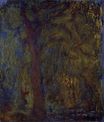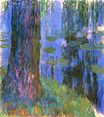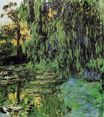Claude Monet - Weeping Willow 1919
 |
 |
 |
 |
 |
 |
 |

Weeping Willow 1919
99x120cm oil/canvas
Kimbell Art Museum, Forth Worth, Texas, USA
The image is only being used for informational and educational purposes
<< Previous G a l l e r y Next >>
From Kimbell Art Museum:
Monet had painted ten Weeping Willow paintings by 1919, apparently in mournful response to the mass tragedy of World War I. Due to the war, Monet’s luxurious compound at Giverny was for the most part emptied of his children’s families and his household staff, who were either called into service or moved away from the advancing German army. His only surviving son was in constant danger at the front. At times Monet could hear artillery fire, but he refused to leave, preferring to share the fate of his gardens. As a group, the Weeping Willow paintings are characterized by shadowy colors and writhing forms, as if Monet intended to express the grieving mood not simply with the subject, but also through an expressionist style of painting. They were among the very few easel-scale paintings that Monet made after 1914, when he claimed his failing eyesight was best suited for working in larger formats. The particular tree portrayed in Weeping Willow had pride of place on the bank of Monet’s water garden, with its exotic water lilies. The tree’s trunk, its cascading branches, and its reflection are all incorporated into his greatest artistic legacy, the mural-scale Nymphéas canvases that were his preoccupation from 1914 until his death.